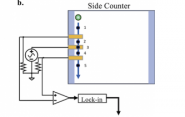Innovative Design Leads to a Better Portable Cell Counter

Coulter counters - small devices that can count cells in a solution and identify them by size - are a potentially attractive tool for health care workers, but creating a portable version for commercial use has proved elusive. A team of researchers at Yale, however, may have solved a critical design challenge that could make similar devices useful for medical treatment in the field.
 Although they’re a promising asset for health care, Coulter counters have suffered from having to trade off the sensitivity of their cell detection capabilities with the volume of the cell samples. In the lab of Mark Reed, the Harold Hodgkinson Professor of Electrical Engineering & Applied Physics, a research team led by two undergraduate students has developed a device that can process a large sample of cells without sacrificing its cell-detecting ability. The results are published this week in Biosensors and Bioelectronics.
Although they’re a promising asset for health care, Coulter counters have suffered from having to trade off the sensitivity of their cell detection capabilities with the volume of the cell samples. In the lab of Mark Reed, the Harold Hodgkinson Professor of Electrical Engineering & Applied Physics, a research team led by two undergraduate students has developed a device that can process a large sample of cells without sacrificing its cell-detecting ability. The results are published this week in Biosensors and Bioelectronics.
Flow cytometry is a versatile technology for cell counting and sorting. Most systems, though, are expensive, complicated, and require trained personnel, all of which makes them unsuitable for point-of-care use. Coulter counters have gained attention as simpler alternatives. In these devices, sample solutions pass through a chamber with an electric field created by electrodes. The innate resistance of the cells allows the device to detect and measure their size and speed. 
One commonly used design features a channel with a narrow section in the middle, the point at which the passing cell is detected. This section is about 20 microns wide, though, while the passing cells are 6 to 10 microns in diameter. Because cells tend to stick to things and each other, groups of cells often accumulate and clog up the channel, which can be fatal to the device.
The Reed research team came up with an innovative structure that gets around this problem.
“We removed the tapered structure and placed the electrodes on the side of the channel,” said Daniel Bacheschi, ‘22, one of the lead authors of the study. By placing the sensing electrodes along one side of the solution channel, an electrical sensing region is developed, instead of mechanically constrained sensing regions. This reduces the chances for clogging and allows for a higher sample volume to be processed in a shorter time.
The researchers incorporated the design with a process known as hydrodynamic focusing, mainly to ensure that the general concept was sound. But their design can be easily integrated with other systems that would simplify the device. Reed said the long-term goal is to use a process known as dielectrophoresis (DEP), which would allow them to “make a very compact electronic system the size of a small chip.”
Co-author Will Polsky ’21 recalled the many afternoons and weekends in the laboratory that he and Bacheschi spent working on the design and the amount of trial and error they needed to get the design to succeed. Now, he’s excited to see its potential.
“Given the high sample throughput of the side counter compared to the Coulter counter device, it will be interesting to see how much higher the sample throughput can go once DEP is implemented in the side counter,” he said.
Co-author Shari Yosinski, a postdoctoral researcher in Reed’s lab, noted that when a counter gets clogged up, it’s often unfixable. That means the innovative structure could be a huge boon for researchers.
“We make all our chips in-house, and any time you break a device, it hurts, because it’s a lot of work to make another one,” she said. “So this was born out of us needing a solution to these headaches we keep having.”
Reed noted that the work is now being extended to real world whole blood samples for proof-of-principle point-of-care devices. He also praised Bacheschi and Polsky for their creative solutions and work on the design.
“I think it's a testament to the caliber of research that can be done by undergraduates here at Yale,” he said.
The development of the devices has been a lab-wide effort. Co-author Zachary Kobos, who received his PhD last year, helped develop the Coulter counter system with constrained channels; and Yosinksi pioneered the microfluidics aspect of the design in addition to making the chips. Prof. Jie Chen of the University of Alberta, who did a sabbatical in Prof. Reed's labs last year, did modeling that verified the device performance.

